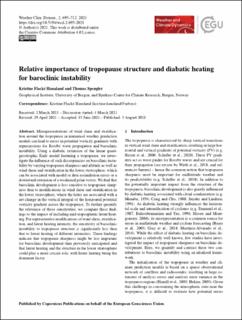| dc.contributor.author | Haualand, Kristine Flacké | |
| dc.contributor.author | Spengler, Thomas | |
| dc.date.accessioned | 2022-04-11T12:19:46Z | |
| dc.date.available | 2022-04-11T12:19:46Z | |
| dc.date.created | 2021-08-03T14:56:03Z | |
| dc.date.issued | 2021 | |
| dc.identifier.issn | 2698-4016 | |
| dc.identifier.uri | https://hdl.handle.net/11250/2990949 | |
| dc.description.abstract | Misrepresentations of wind shear and stratification around the tropopause in numerical weather prediction models can lead to errors in potential vorticity gradients with repercussions for Rossby wave propagation and baroclinic instability. Using a diabatic extension of the linear quasi-geostrophic Eady model featuring a tropopause, we investigate the influence of such discrepancies on baroclinic instability by varying tropopause sharpness and altitude as well as wind shear and stratification in the lower stratosphere, which can be associated with model or data assimilation errors or a downward extension of a weakened polar vortex. We find that baroclinic development is less sensitive to tropopause sharpness than to modifications in wind shear and stratification in the lower stratosphere, where the latter are associated with a net change in the vertical integral of the horizontal potential vorticity gradient across the tropopause. To further quantify the relevance of these sensitivities, we compare these findings to the impact of including mid-tropospheric latent heating. For representative modifications of wind shear, stratification, and latent heating intensity, the sensitivity of baroclinic instability to tropopause structure is significantly less than that to latent heating of different intensities. These findings indicate that tropopause sharpness might be less important for baroclinic development than previously anticipated and that latent heating and the structure in the lower stratosphere could play a more crucial role, with latent heating being the dominant factor. | en_US |
| dc.language.iso | eng | en_US |
| dc.publisher | Copernicus Publications | en_US |
| dc.rights | Navngivelse 4.0 Internasjonal | * |
| dc.rights.uri | http://creativecommons.org/licenses/by/4.0/deed.no | * |
| dc.title | Relative importance of tropopause structure and diabatic heating for baroclinic instability | en_US |
| dc.type | Journal article | en_US |
| dc.type | Peer reviewed | en_US |
| dc.description.version | publishedVersion | en_US |
| dc.rights.holder | Copyright 2021 The Author(s) | en_US |
| cristin.ispublished | true | |
| cristin.fulltext | original | |
| cristin.qualitycode | 1 | |
| dc.identifier.doi | 10.5194/wcd-2-695-2021 | |
| dc.identifier.cristin | 1923698 | |
| dc.source.journal | Weather and Climate Dynamics (WCD) | en_US |
| dc.source.pagenumber | 695-712 | en_US |
| dc.identifier.citation | Weather and Climate Dynamics (WCD). 2021, 2 (3), 695-712. | en_US |
| dc.source.volume | 2 | en_US |
| dc.source.issue | 3 | en_US |

